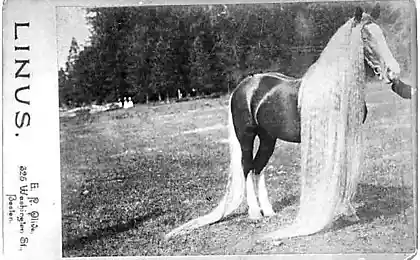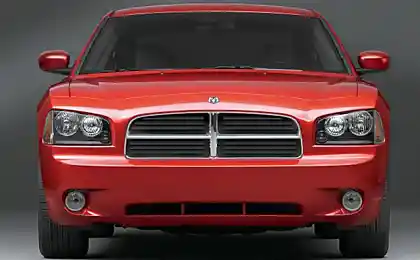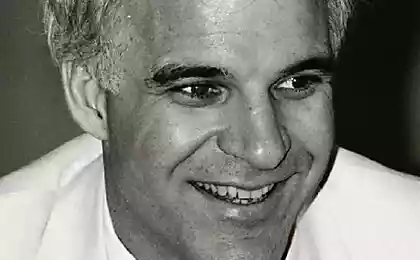2087
Unprofitable handsome
Writes Andrew Valuev: Last Friday was in the territory of Zhukovsky LII. Gromov, where there are at once two of our famous Tu-144. Famous aircraft there certainly is worth more, but in this case we speak of a Tu-144 with the hull number USSR-77115.
It is this aircraft now rolling out on static display during the MAKS International and the event usually attracts a lot of attention. This aircraft was created as a testing laboratory. This modification of the Tu-144, and this is one of the latest released models for long-haul flights. Unlike the first model installed on it more fuel-efficient engines. Initially, the aircraft was designed for high-speed flight from Moscow to the Far East of the USSR, but as consumption of engines NK-114 was too high, then the plane was a maximum range of 3,500 km, which allowed them to put only on flights from Moscow to Alma-Ata.
29 photos
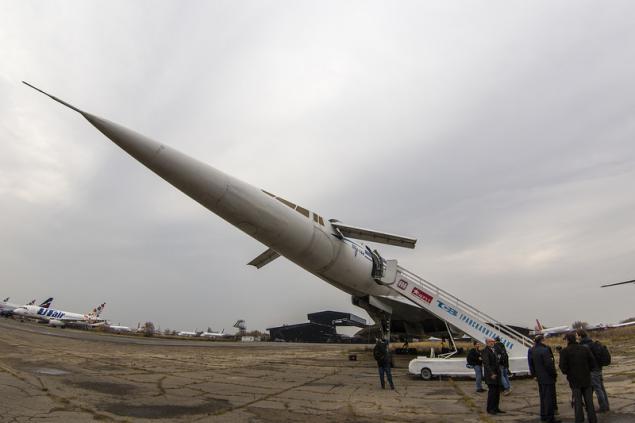
The second half of the 20th century was accompanied by technological progress itself century was the century of speeds. With the size of our country was unthinkable to spend 12-16 hours in flight from one end of the country to another. Almost simultaneously with Aérospatiale-BAC Concorde in Tupolev Design Bureau began development of a supersonic airliner capable of 3 times faster to cross our country and deliver high comfort of passengers.
For its time, the aircraft was unique, with many innovative inventions. For the first time in commercial aviation scheme was used "flying wing" or bezhvostka. The aircraft did not have a tail horizontal tail. Also in the design of the wing were missing slats and flaps. To increase the horizontal balancing at low speeds were created front wings, as well as a scheme of deviation sock cabin. Originally designed scheme denies the cockpit or telemetry system or a system periscopes. Thanks to the front winglets plane had significantly smaller than the speed of Concorde taking off and landing. Tu-144 could sit and take off at 18 airports in the USSR, while the "Concord", takeoff and landing speed which was 15% higher for each airport required a separate certificate for landing.
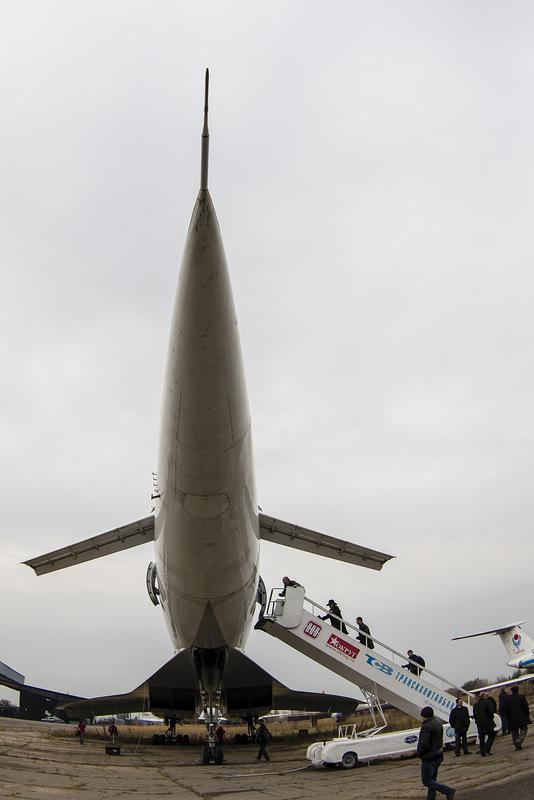
The shape of the wing has been designed based on the model of the MiG-21 - the developers simply pasted on the model bridge between the wing and tail horizontal tail. The company also created the MiG-21I which already brought contours of the wing. (Now the plane is in the Aviation Museum in Monino).
Just have developed a special kinematics of the landing gear - wheel truck chassis was designed under a heavy load during landing and had a very impressive size. In order to save size landing gear wheel truck at harvest unfolded 90 gladusov and evolved more compact, allowing it to place in the gap between the two pods.
The first flight of the Tu-144 took place December 31, 1968 (his test performed OKB Tupolev Edward Yelyan), that is, two months ahead of "Concord". Tu-144 is also the first in the history of passenger airliner to break the sound barrier, it happened (June 5, 1969) at an altitude of 11,000 meters.
Next symbolic milestone in the Mach 2 aircraft overcame May 25, 1970, to make a flight at an altitude of 16,300 meters at a speed of 2150 km / h.
Production aircraft were deployed at the Voronezh plant № 64. At the time of failure of the operation was built 16 Tu-144 (the building of four more aircraft was never completed), which made a total of 2556 sorties and flew 4110 hours
During the first demonstration of the aircraft at Le Bourget June 3, 1973 there was an accident that claimed the lives of six members of the crew.
Despite the catastrophe of 1973, after the aircraft was re-shown at Le Bourget in 1975 and 1977.
Summer of 1977, Leonid Brezhnev makes a state visit to France, where he demonstrated "Concord", which is already a year performs passenger flights to Bahrain and Rio de Janeiro. Brezhnev ordered the Minister of Civil Aviation of the USSR Bugaev begin preparatory work on the exit of the Tu-144 on the route and transportation of passengers.
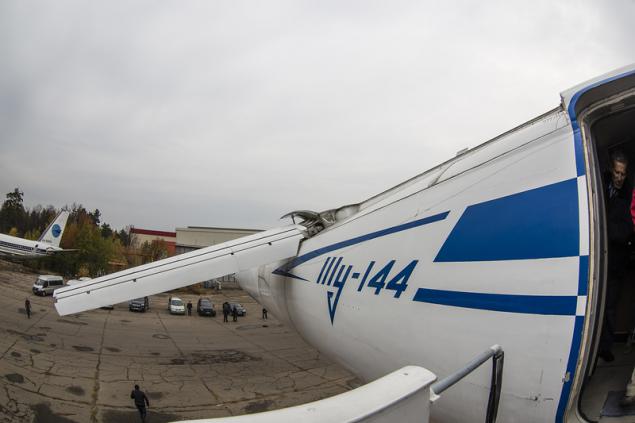
During the first demonstration flight for the press, which was accomplished from Moscow's Vnukovo airport during takeoff powerful jets of air from the engines of the aircraft was torn portion of runway and landing made already on alternate aerodrome. More at Vnukovo airport the plane did not appear. Flights were made from Domodedovo airport.
The first working trip - December 26, 1975 on the route Moscow - Alma-Ata, the plane moved mailings, and from 1 November 1977, in the same direction and began passenger service.
Start of operation of passenger Tu-144 was timed to the 60th anniversary of the October Revolution. Flights are operated only two aircraft - № 77109 and № 77110. piloted their specially trained crews of "Aeroflot", which included test-pilots Tupolev as co-pilots, aircraft commanders were retrained pilots of "Aeroflot". Ticket for this flight cost 80 rubles, whereas in conventional subsonic plane ticket to Alma-Ata was worth 62 rubles. This flight was number 499 and was carried out once a week. Service on board was carried out by first class and included caviar and expensive cognacs. At the same time, also worked on the Concorde VIP class and carrying top officials, such as the Queen of Great Britain and pop stars. Concorde ticket to cost a few thousand dollars
The longest non-stop scheduled flight of the Tu-144 was the route Moscow - Khabarovsk, length of 6250 km. The longest flight with landing - on the route Paris - Novosibirsk - Tokyo, with a total length of 11 200 km. Was slightly shorter route Moscow - Azores - Havana (10 400 km).
However, commercial career Tu-144 was short-lived. June 1, 1978, just seven months after the start of commercial operation, "Aeroflot" stopped supersonic passenger flights. The immediate reason for the termination of passenger flights was the catastrophe prototype Tu-144, which took place a week earlier (see. Below). More fundamental reason for the refusal of the passenger operation called unprofitable. Although tickets for supersonic flight, the price of which was one and a half times higher than normal, sold out long before the departure, they did not cover even a small part of the operating costs due to high specific fuel consumption at cruising and complex service. A significant increase in the cost of tickets in the Soviet Union, where there was a class of rich people (as opposed to Western consumers "Concord"), had no prospects. In addition, a small range of a first modification (3-4 thousand km), which could allow the engines NK-144A, and less than that of the "Concord" range with the new RD-36-51A (5 thousand km) also restrict or complicated and costly (with stopovers) passenger operation opportunities both at home and abroad on long intercontinental and transcontinental routes where the target reduction of flight time is especially noticeable at supersonic speed.
Subsequently, the Tu-144 was used only for some urgent and special freight traffic between Moscow and Khabarovsk and others.
In total, the Tu-144 made 102 flights under the flag of Aeroflot, 55 passengers (passengers were transported 3194).
Later, the Tu-144 made only a few test flights and flights with a view to establishing world records.
From 1995 to 1999, a significantly modified Tu-144 (№ 77114) called Tu-144LL ("Flying Laboratory") was used by the American space agency NASA for research in the field of high-speed commercial flights in order to develop a plan to create a new modern supersonic passenger aircraft. Tu-144LL engines were installed NC-32 (similar to those used on the Tu-160) due to the lack of usable NK-144 or RD-36-51, a variety of sensors and test control and recording equipment. After completion of the flight engines were dismantled. The plane is now just stands in Zhukovsky, and probably will be part of the created National Aviation Museum in Zhukovsky. Now, a draft of the museum. In the museum as well go down and the last one issued Buranov (now is his recovery)
But back to this Tu-144 Soviet-77115: Airplane for 20 years was bezhoznym and even planned his disposal, but managed to save him.
In 2007, the Tu-144 number 77115 was re-painted in accordance with the historical color scheme and exposed for all to see at MAKS-2007, as well as at MAKS-2009 MAKS-2011 and MAX 2013
Now he belongs to the Scientific and Engineering Company
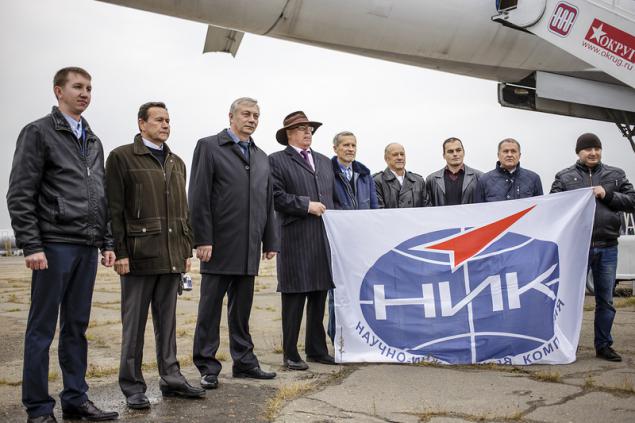
The aircraft is in flight to a recoverable state. In the near future aircraft will be installed as a memorial museum in the center of Zhukovsky. The specific location is being specified. The question is controlled by the mayor of the city of Zhukovsky Andrew Voytyuk
The photo Voytyuk Andrew, one of the founders of the plane Alexander Leonidovich Pukhov and keeper of the aircraft Alexey Amelyushkin
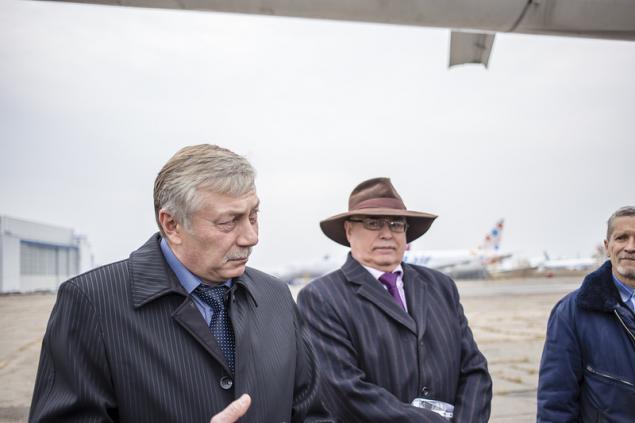
06
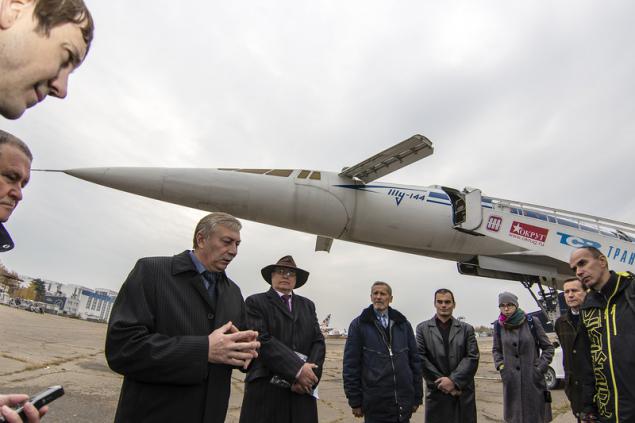
Climb into the plane
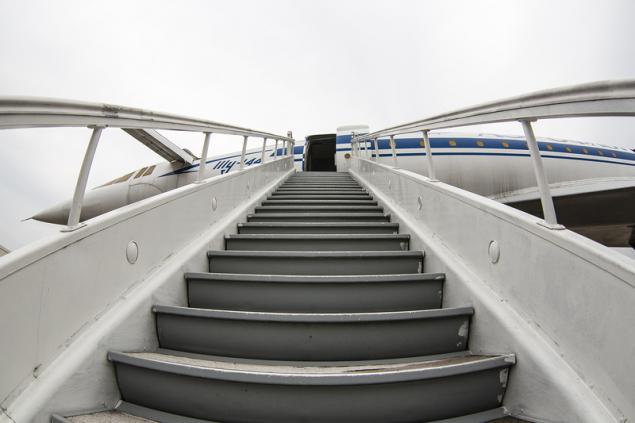
In one of the salons now liner exposure supersonic passenger aviation
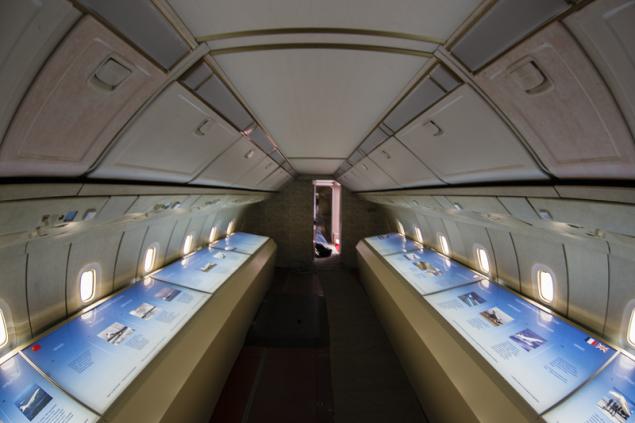
This board was created only for flight tests and was never equipped with passenger seats. In general, the Tu-144 was a little more comfortable thanks to the width of the fuselage Concord
Another difference from the passenger version - emergency release valve internal pressure
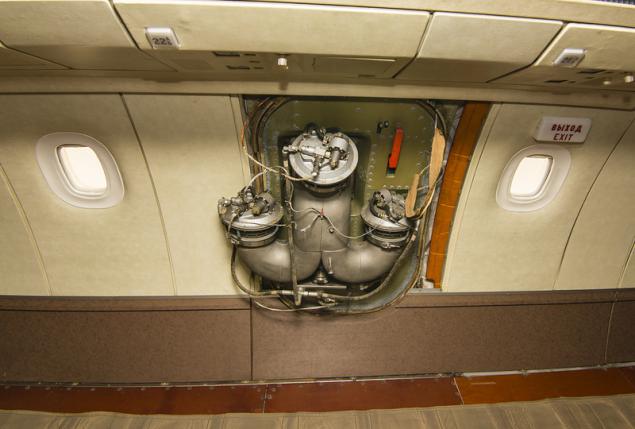
Flying in an airplane altitudes of up to 20,000 meters. This aircraft during test flights could make sharp elevation changes and this was such a valve is installed, otherwise the plane from excessive internal pressure could break. In passenger ships is automatically maintained internal pressure equal to the pressure at an altitude of 2,000 to 3,000 meters.
Tail section of the liner with the electronics. Then there is a compartment with a parachute brake system. Unlike other aircraft APU in the Tu-144 was located between 3 and 4 nacelles
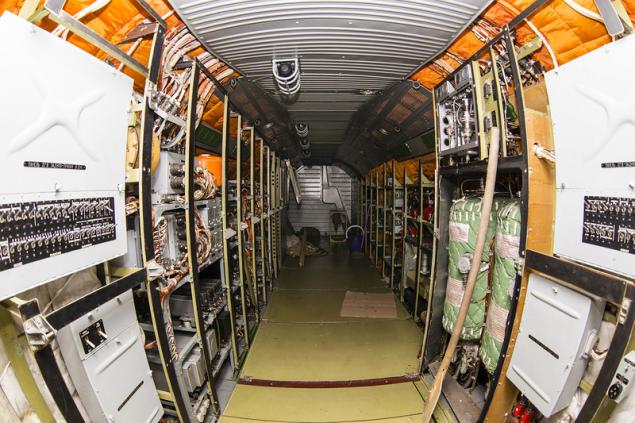
On board the plane a little talked with his creator Alexander Leonidovich Pukhov - aircraft, Professor. Since 1962 he has worked in the Yakovlev Design Bureau. Tupolev. The chief designer, runs a program of supersonic passenger aircraft. Participated in the development of the Tu-144, Tu-144LL, Tu-160, Tu-244, Tu-344. Has 28 inventor's certificates and 5 international patents.
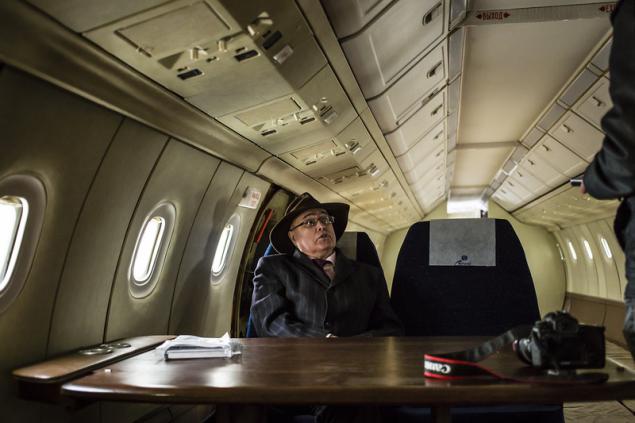
12
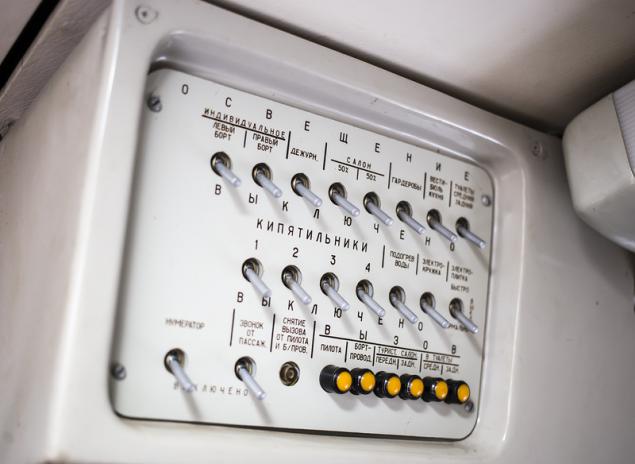
13
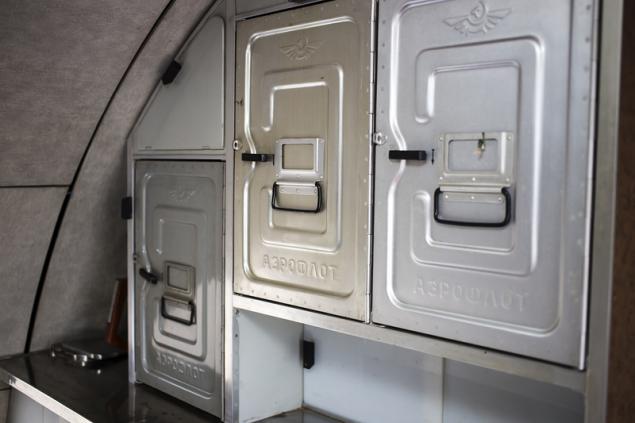
14
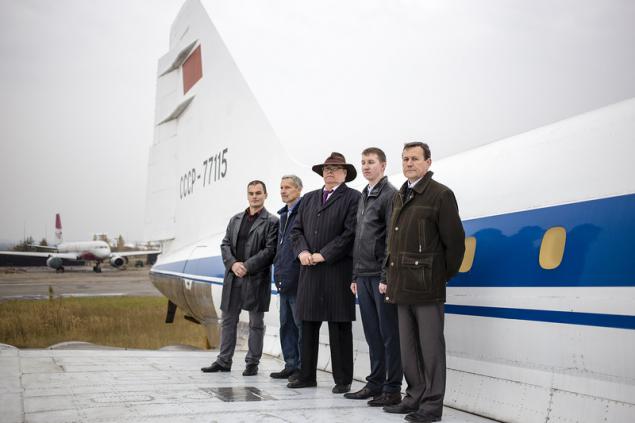
Well, look at the cockpit. In this configuration, the nose is raised
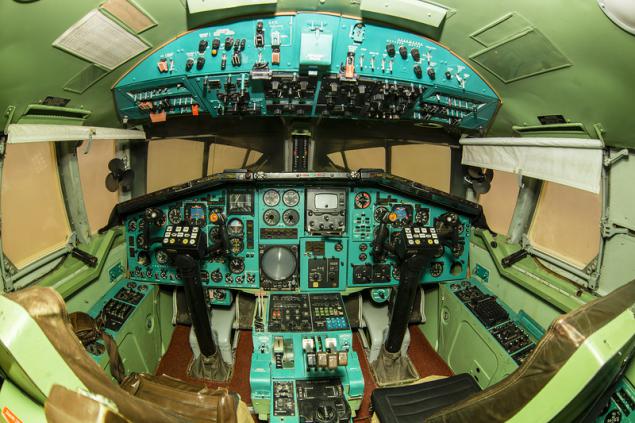
The aircraft crew consisted of 4 persons
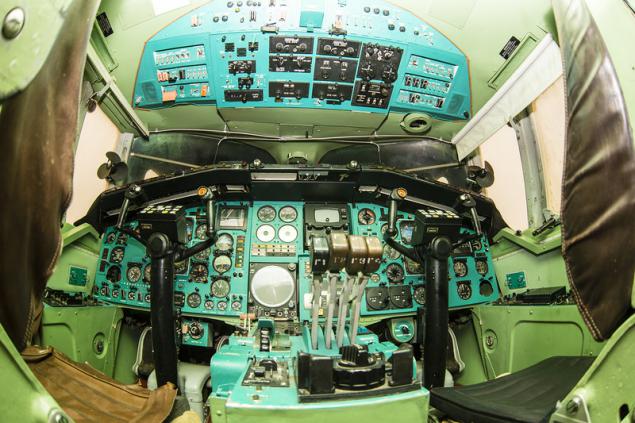
Workplace flight engineer
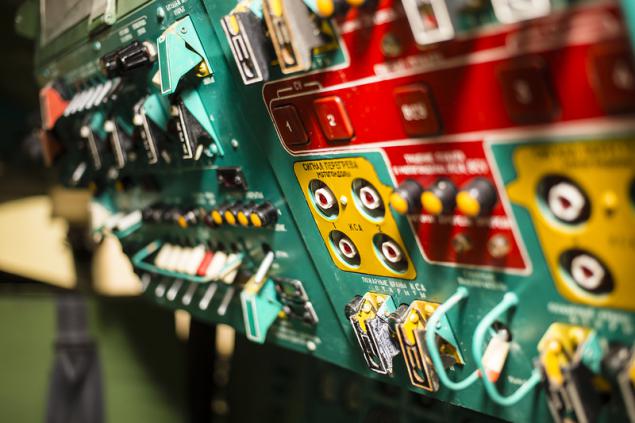
18
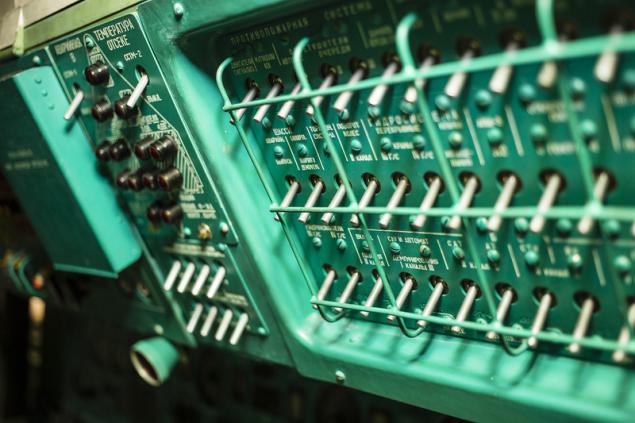
19
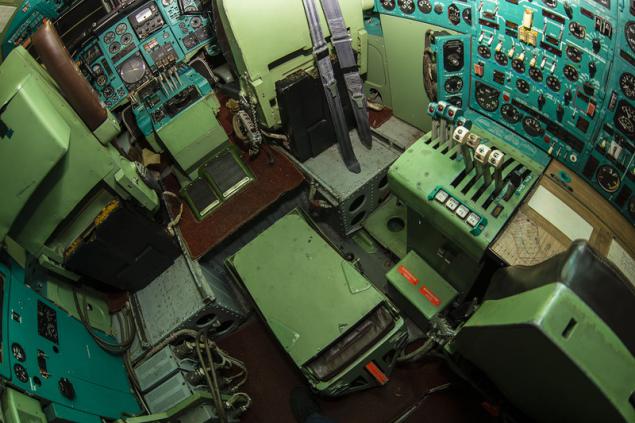
20
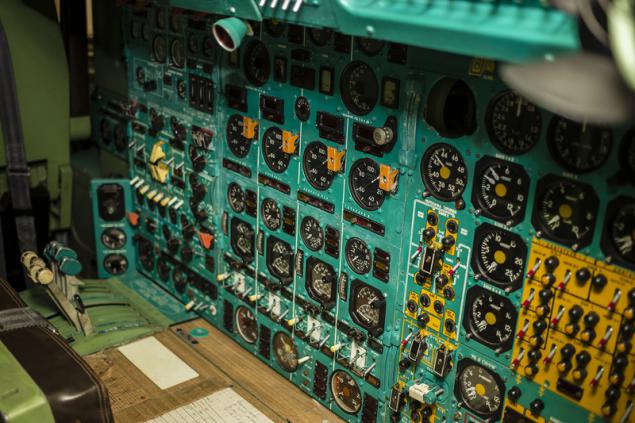
21
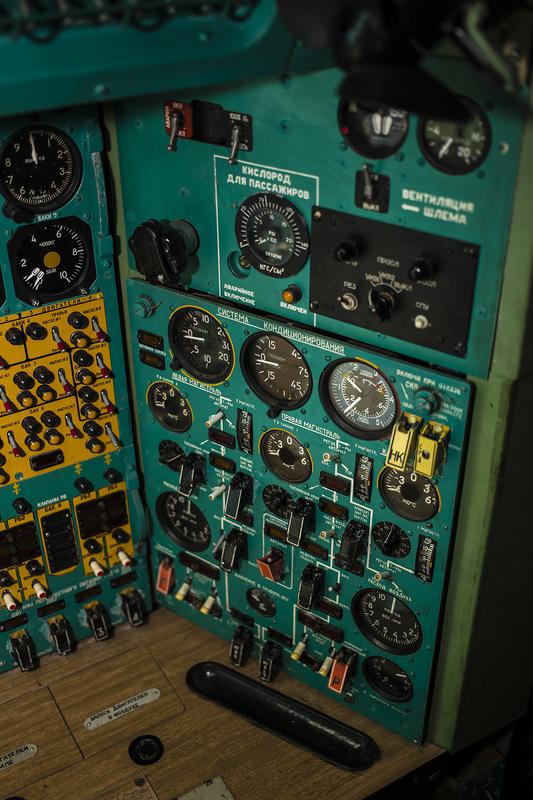
22
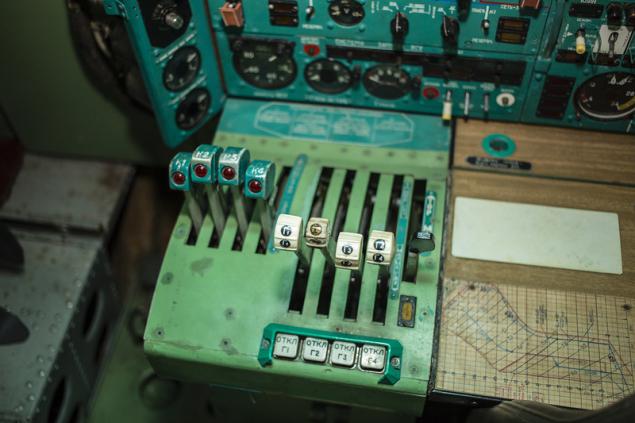
23
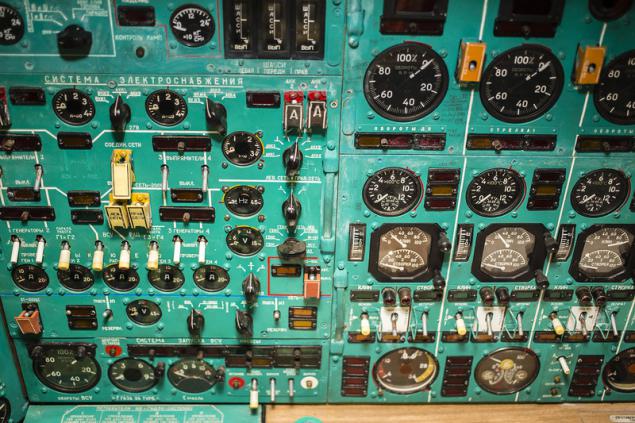
24
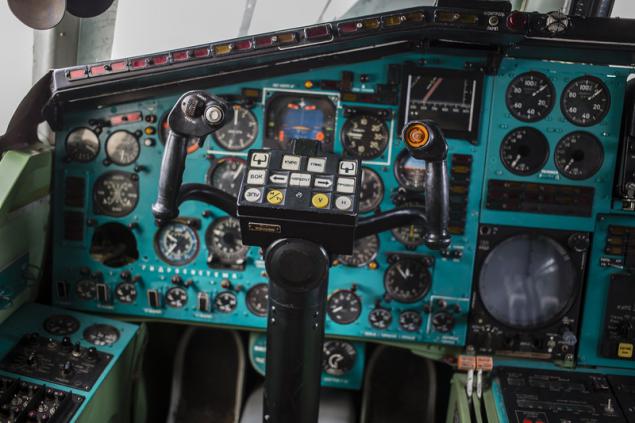
Nose landing gear. If you look closely, you can find it on the plates gryazezaschity.
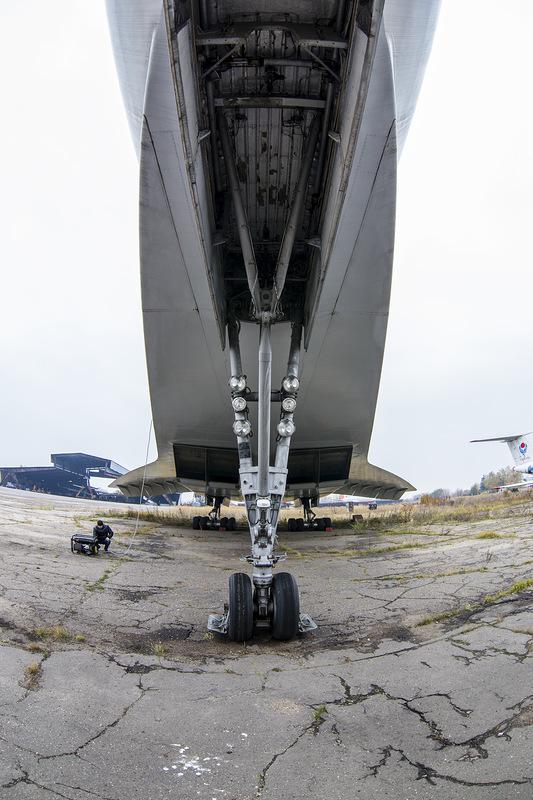
The main landing gear strut
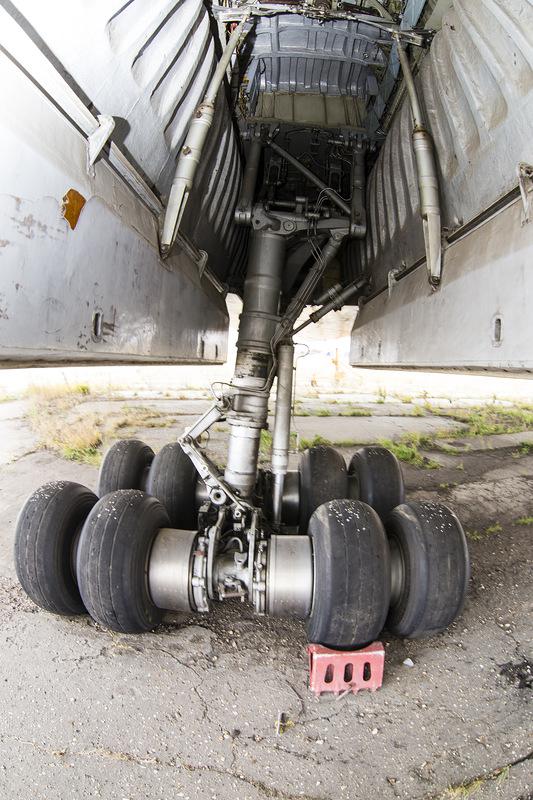
27
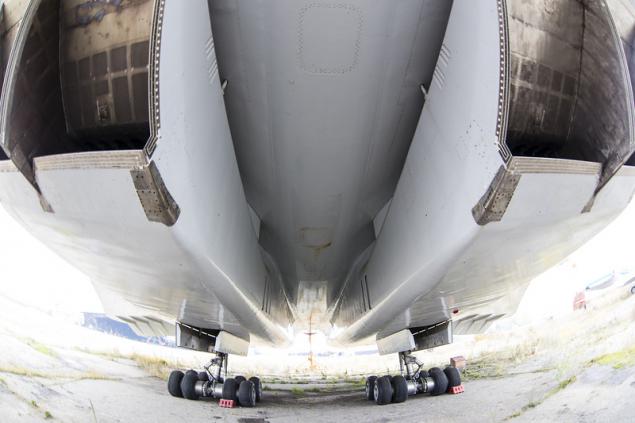
28
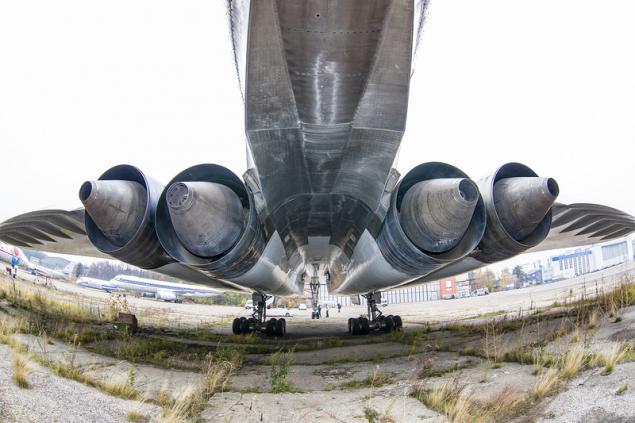
29
It seems to me a very beautiful car
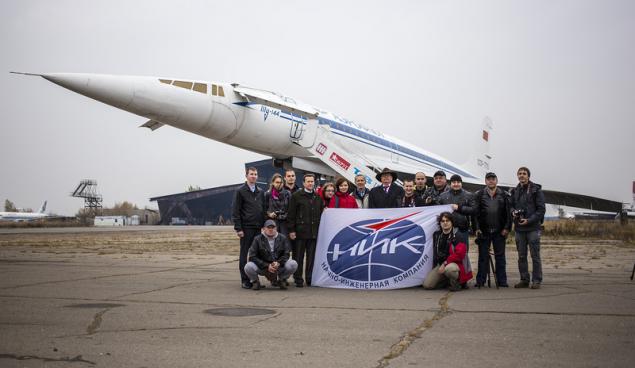
It is this aircraft now rolling out on static display during the MAKS International and the event usually attracts a lot of attention. This aircraft was created as a testing laboratory. This modification of the Tu-144, and this is one of the latest released models for long-haul flights. Unlike the first model installed on it more fuel-efficient engines. Initially, the aircraft was designed for high-speed flight from Moscow to the Far East of the USSR, but as consumption of engines NK-114 was too high, then the plane was a maximum range of 3,500 km, which allowed them to put only on flights from Moscow to Alma-Ata.
29 photos

The second half of the 20th century was accompanied by technological progress itself century was the century of speeds. With the size of our country was unthinkable to spend 12-16 hours in flight from one end of the country to another. Almost simultaneously with Aérospatiale-BAC Concorde in Tupolev Design Bureau began development of a supersonic airliner capable of 3 times faster to cross our country and deliver high comfort of passengers.
For its time, the aircraft was unique, with many innovative inventions. For the first time in commercial aviation scheme was used "flying wing" or bezhvostka. The aircraft did not have a tail horizontal tail. Also in the design of the wing were missing slats and flaps. To increase the horizontal balancing at low speeds were created front wings, as well as a scheme of deviation sock cabin. Originally designed scheme denies the cockpit or telemetry system or a system periscopes. Thanks to the front winglets plane had significantly smaller than the speed of Concorde taking off and landing. Tu-144 could sit and take off at 18 airports in the USSR, while the "Concord", takeoff and landing speed which was 15% higher for each airport required a separate certificate for landing.

The shape of the wing has been designed based on the model of the MiG-21 - the developers simply pasted on the model bridge between the wing and tail horizontal tail. The company also created the MiG-21I which already brought contours of the wing. (Now the plane is in the Aviation Museum in Monino).
Just have developed a special kinematics of the landing gear - wheel truck chassis was designed under a heavy load during landing and had a very impressive size. In order to save size landing gear wheel truck at harvest unfolded 90 gladusov and evolved more compact, allowing it to place in the gap between the two pods.
The first flight of the Tu-144 took place December 31, 1968 (his test performed OKB Tupolev Edward Yelyan), that is, two months ahead of "Concord". Tu-144 is also the first in the history of passenger airliner to break the sound barrier, it happened (June 5, 1969) at an altitude of 11,000 meters.
Next symbolic milestone in the Mach 2 aircraft overcame May 25, 1970, to make a flight at an altitude of 16,300 meters at a speed of 2150 km / h.
Production aircraft were deployed at the Voronezh plant № 64. At the time of failure of the operation was built 16 Tu-144 (the building of four more aircraft was never completed), which made a total of 2556 sorties and flew 4110 hours
During the first demonstration of the aircraft at Le Bourget June 3, 1973 there was an accident that claimed the lives of six members of the crew.
Despite the catastrophe of 1973, after the aircraft was re-shown at Le Bourget in 1975 and 1977.
Summer of 1977, Leonid Brezhnev makes a state visit to France, where he demonstrated "Concord", which is already a year performs passenger flights to Bahrain and Rio de Janeiro. Brezhnev ordered the Minister of Civil Aviation of the USSR Bugaev begin preparatory work on the exit of the Tu-144 on the route and transportation of passengers.

During the first demonstration flight for the press, which was accomplished from Moscow's Vnukovo airport during takeoff powerful jets of air from the engines of the aircraft was torn portion of runway and landing made already on alternate aerodrome. More at Vnukovo airport the plane did not appear. Flights were made from Domodedovo airport.
The first working trip - December 26, 1975 on the route Moscow - Alma-Ata, the plane moved mailings, and from 1 November 1977, in the same direction and began passenger service.
Start of operation of passenger Tu-144 was timed to the 60th anniversary of the October Revolution. Flights are operated only two aircraft - № 77109 and № 77110. piloted their specially trained crews of "Aeroflot", which included test-pilots Tupolev as co-pilots, aircraft commanders were retrained pilots of "Aeroflot". Ticket for this flight cost 80 rubles, whereas in conventional subsonic plane ticket to Alma-Ata was worth 62 rubles. This flight was number 499 and was carried out once a week. Service on board was carried out by first class and included caviar and expensive cognacs. At the same time, also worked on the Concorde VIP class and carrying top officials, such as the Queen of Great Britain and pop stars. Concorde ticket to cost a few thousand dollars
The longest non-stop scheduled flight of the Tu-144 was the route Moscow - Khabarovsk, length of 6250 km. The longest flight with landing - on the route Paris - Novosibirsk - Tokyo, with a total length of 11 200 km. Was slightly shorter route Moscow - Azores - Havana (10 400 km).
However, commercial career Tu-144 was short-lived. June 1, 1978, just seven months after the start of commercial operation, "Aeroflot" stopped supersonic passenger flights. The immediate reason for the termination of passenger flights was the catastrophe prototype Tu-144, which took place a week earlier (see. Below). More fundamental reason for the refusal of the passenger operation called unprofitable. Although tickets for supersonic flight, the price of which was one and a half times higher than normal, sold out long before the departure, they did not cover even a small part of the operating costs due to high specific fuel consumption at cruising and complex service. A significant increase in the cost of tickets in the Soviet Union, where there was a class of rich people (as opposed to Western consumers "Concord"), had no prospects. In addition, a small range of a first modification (3-4 thousand km), which could allow the engines NK-144A, and less than that of the "Concord" range with the new RD-36-51A (5 thousand km) also restrict or complicated and costly (with stopovers) passenger operation opportunities both at home and abroad on long intercontinental and transcontinental routes where the target reduction of flight time is especially noticeable at supersonic speed.
Subsequently, the Tu-144 was used only for some urgent and special freight traffic between Moscow and Khabarovsk and others.
In total, the Tu-144 made 102 flights under the flag of Aeroflot, 55 passengers (passengers were transported 3194).
Later, the Tu-144 made only a few test flights and flights with a view to establishing world records.
From 1995 to 1999, a significantly modified Tu-144 (№ 77114) called Tu-144LL ("Flying Laboratory") was used by the American space agency NASA for research in the field of high-speed commercial flights in order to develop a plan to create a new modern supersonic passenger aircraft. Tu-144LL engines were installed NC-32 (similar to those used on the Tu-160) due to the lack of usable NK-144 or RD-36-51, a variety of sensors and test control and recording equipment. After completion of the flight engines were dismantled. The plane is now just stands in Zhukovsky, and probably will be part of the created National Aviation Museum in Zhukovsky. Now, a draft of the museum. In the museum as well go down and the last one issued Buranov (now is his recovery)
But back to this Tu-144 Soviet-77115: Airplane for 20 years was bezhoznym and even planned his disposal, but managed to save him.
In 2007, the Tu-144 number 77115 was re-painted in accordance with the historical color scheme and exposed for all to see at MAKS-2007, as well as at MAKS-2009 MAKS-2011 and MAX 2013
Now he belongs to the Scientific and Engineering Company

The aircraft is in flight to a recoverable state. In the near future aircraft will be installed as a memorial museum in the center of Zhukovsky. The specific location is being specified. The question is controlled by the mayor of the city of Zhukovsky Andrew Voytyuk
The photo Voytyuk Andrew, one of the founders of the plane Alexander Leonidovich Pukhov and keeper of the aircraft Alexey Amelyushkin

06

Climb into the plane

In one of the salons now liner exposure supersonic passenger aviation

This board was created only for flight tests and was never equipped with passenger seats. In general, the Tu-144 was a little more comfortable thanks to the width of the fuselage Concord
Another difference from the passenger version - emergency release valve internal pressure

Flying in an airplane altitudes of up to 20,000 meters. This aircraft during test flights could make sharp elevation changes and this was such a valve is installed, otherwise the plane from excessive internal pressure could break. In passenger ships is automatically maintained internal pressure equal to the pressure at an altitude of 2,000 to 3,000 meters.
Tail section of the liner with the electronics. Then there is a compartment with a parachute brake system. Unlike other aircraft APU in the Tu-144 was located between 3 and 4 nacelles

On board the plane a little talked with his creator Alexander Leonidovich Pukhov - aircraft, Professor. Since 1962 he has worked in the Yakovlev Design Bureau. Tupolev. The chief designer, runs a program of supersonic passenger aircraft. Participated in the development of the Tu-144, Tu-144LL, Tu-160, Tu-244, Tu-344. Has 28 inventor's certificates and 5 international patents.

12

13

14

Well, look at the cockpit. In this configuration, the nose is raised

The aircraft crew consisted of 4 persons

Workplace flight engineer

18

19

20

21

22

23

24

Nose landing gear. If you look closely, you can find it on the plates gryazezaschity.

The main landing gear strut

27

28

29
It seems to me a very beautiful car











